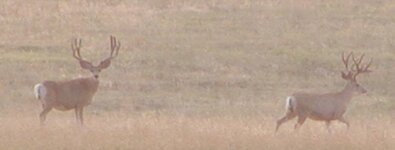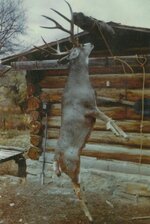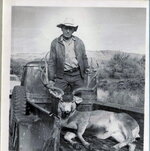idelkslayer
WKR
I'm going to call back to one of the data points in the OP. What is everyone's thoughts on the Colorado study that found an inverse relationship between buck : doe ratios and fawn : doe ratios?
To quote from the study:
"Two evaluations of Colorado's harvest management decisions have occurred (Bishop et al. 2005, Bergman et al. 2011). Each of these was an evaluation of restrictions to deer hunting, and primarily within this, restrictions on the hunting of adult male deer. In each case, as harvest was restricted, an increase in adult male:adult female ratios was observed. In particular, ratios increased by as many as 4.52 adult males per 100 adult females in one study (Bishop et al. 2005) and by as many as 21.86 adult males per 100 adult females in the other study (Bergman et al. 2011). However, simultaneous declines in fawn:adult female ratios were observed as part of each study. Declines were as high as 6.96 fawns per 100 adult females (Bergman et al. 2011) and 7.51 fawns per 100 adult females (Bishop et al. 2005). While neither study was a direct experimental evaluation of intraspecific competition or density dependence, both studies provide circumstantial evidence that increasing the proportion of adult male deer in the population came at the expense of population productivity. Interaction between the male, female, and young components of populations, similar to that presented by Bishop et al. (2005) and Bergman et al. (2011), can result in second order feedback effects that are non-trivial (Mysterud et al. 2002). If lowered fawn:adult female ratios can be interpreted as an indicator of suppressed population growth, the studies of Bishop et al. (2005) and Bergman et al. (2011) may provide evidence that harvest decisions that change the sex and age structure of deer herds to favor mature animals may have a regulating effect — thereby slowing the rate of population growth (dN/dt) by reducing the per capita rate of change (R) in our conceptual model. Moreover, at a given population size (N), a herd with a higher proportion of males has a lower reproductive potential because it has a lower proportion of females. In the event of stochastic reductions in K due to harsh winters, die-offs in herds with a higher proportion of males may experience delayed rebounding (i.e. sex ratio may have a regulating effect on population growth). Colorado's current statewide ratio of total males to adult females, when weighted by herd size, is 33.4 adult males per 100 adult females (Colorado Parks and Wildlife unpubl.). However, it is unknown if sex ratios at this level have a regulating effect."
It seems like there is a lot that isn't understood but future research could be targeted at understanding why fawn ratios go down, the long term effect of lower fawn ratios, and where is the tipping point between high buck : doe ratios that precipitates a decline in fawn : doe ratios.
To quote from the study:
"Two evaluations of Colorado's harvest management decisions have occurred (Bishop et al. 2005, Bergman et al. 2011). Each of these was an evaluation of restrictions to deer hunting, and primarily within this, restrictions on the hunting of adult male deer. In each case, as harvest was restricted, an increase in adult male:adult female ratios was observed. In particular, ratios increased by as many as 4.52 adult males per 100 adult females in one study (Bishop et al. 2005) and by as many as 21.86 adult males per 100 adult females in the other study (Bergman et al. 2011). However, simultaneous declines in fawn:adult female ratios were observed as part of each study. Declines were as high as 6.96 fawns per 100 adult females (Bergman et al. 2011) and 7.51 fawns per 100 adult females (Bishop et al. 2005). While neither study was a direct experimental evaluation of intraspecific competition or density dependence, both studies provide circumstantial evidence that increasing the proportion of adult male deer in the population came at the expense of population productivity. Interaction between the male, female, and young components of populations, similar to that presented by Bishop et al. (2005) and Bergman et al. (2011), can result in second order feedback effects that are non-trivial (Mysterud et al. 2002). If lowered fawn:adult female ratios can be interpreted as an indicator of suppressed population growth, the studies of Bishop et al. (2005) and Bergman et al. (2011) may provide evidence that harvest decisions that change the sex and age structure of deer herds to favor mature animals may have a regulating effect — thereby slowing the rate of population growth (dN/dt) by reducing the per capita rate of change (R) in our conceptual model. Moreover, at a given population size (N), a herd with a higher proportion of males has a lower reproductive potential because it has a lower proportion of females. In the event of stochastic reductions in K due to harsh winters, die-offs in herds with a higher proportion of males may experience delayed rebounding (i.e. sex ratio may have a regulating effect on population growth). Colorado's current statewide ratio of total males to adult females, when weighted by herd size, is 33.4 adult males per 100 adult females (Colorado Parks and Wildlife unpubl.). However, it is unknown if sex ratios at this level have a regulating effect."
It seems like there is a lot that isn't understood but future research could be targeted at understanding why fawn ratios go down, the long term effect of lower fawn ratios, and where is the tipping point between high buck : doe ratios that precipitates a decline in fawn : doe ratios.




